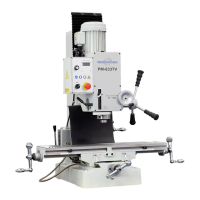19
PM-833TV 4-13-21V1.indd Copyright © 2021 Quality Machine Tools, LLC
INSTALLING & INDICATING A VISE
For routine milling operations, the workpiece is usually
held in a precision vise. For the PM-833TV, a 4” vise is
highly suitable. “Indicating” means checking the align-
ment of the xed (back) vise jaw relative to the axis of
table motion.
Install the T-bolts and align the vise by eye. With one of
the clamp nuts snug, but not tight, tighten the other one
just short of fully-tight (but tight enough so the vise won’t
budge without a denite tap from a dead-blow mallet).
A typical setup for indicating is shown in Figure 3-20.
There is no spindle lock, but you need to make sure
that the spindle does not rotate throughout the pro-
cedure. Set the indicator tip against the upper edge of a
precision reference bar or, if not available, use the front
face of the xed jaw of the vise instead (check for dings,
hone if necessary). Adjust the Y-axis to pre-load the indi-
cator to mid range at the tightly-clamped side of the vise,
then lock the Y-axis.
Note the indicator reading, then watch the indicator as
you traverse the table slowly toward the loosely clamped
side. Ideally, there should be no discrepancy between
the indicator readings at the two ends — unlikely at the
rst attempt. Return the table to the starting point, then
repeat the process, tapping the vise in as you go. Re-
peat the process as often as necessary for the desired
accuracy, progressively tightening the “looser” nut. Now
fully tighten both nuts, and re-check again (tightening a
nut can itself introduce signicant error). An established
routine like this – tight to loose – can save a lot of time.
There is no “right” setup for a vise, but as a starting point
aim for an indicator dierence of no more than ± 0.001”
over the width of the jaw.
Figure 3-20 Indicating the vise
The tip of a standard dial indicator, arrowed, rides on
the face of a at (ground) reference bar.
VISE KEYS
Most precision vises come with key slots on the under-
side, machined exactly parallel to the xed jaw. Key
slots, Figure 3-21, can be a great time saver. Proper-
ly installed, they allow the vise to be removed and re-
placed routinely, accurately enough for general machin-
ing without the need for indicating every time.
Most 4” vises have either 14 mm or 16 mm slots, calling
for shop-made T-shape adapter keys as Figure 3-22. It
is well worth the eort to make these precisely.
Aim for a snug t in both vise and table, but not so tight
that it takes more than reasonable eort to lift the vise
clear. The objective is allow the vise to be removed and
replaced routinely, accurately enough for general ma-
chining without the need for indicating every time.
Case hardening of the keys is recommended, with nal
tting using a ne stone or diamond hone.
Figure 3-21 Keys installed on X-axis of vise
On most vises the keys can also be installed on the long axis
Figure 3-22 Shop-made vise key
Dimensions in
millimeters

